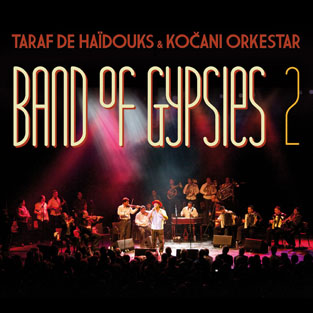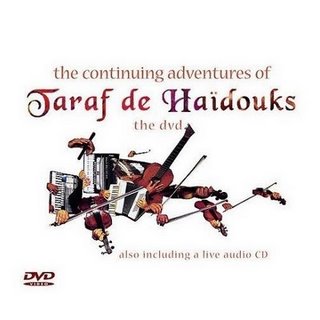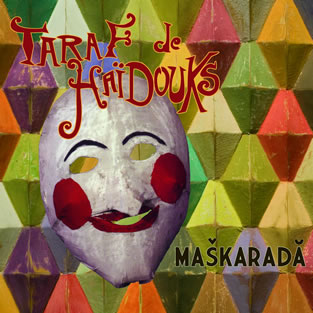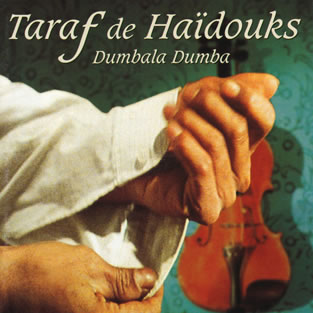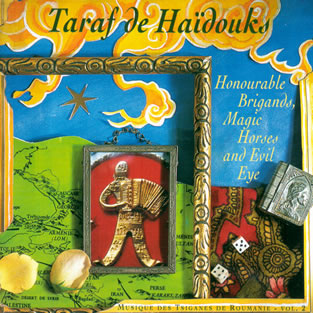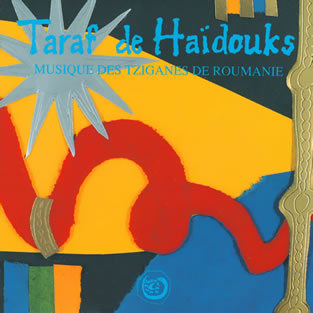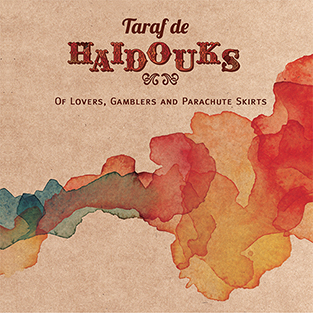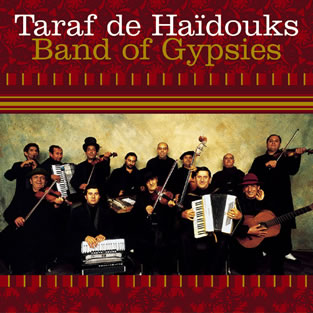
Recorded in Bucharest during three special concerts and additional studio recordings in december 2000, "Band Of Gypsies" is the fourth album by Romanian band Taraf de Haïdouks.
Always eager to expand the scope of their music, the "best Gypsy band in the world" (as recently described by UK daily The Independent) decided to confront their styles to those of other Balkan countries by inviting Gypsy virtuoso musicians from Macedonia (the Koçani Orkestar brass band), Bulgaria (clarinet player Filip Simeonov) and Turkey (percussionist Tarik Tuysuzoglu) to join them on stage. The result is a series of exciting mixtures in which magical moments abound.
Along with these ambitious compositions one will rediscover with great pleasure the fantastic atmosphere of a Taraf de Haïdouks live performance in a collection of previously-unrecorded pieces featuring the various singers and soloists in top form and particularly galvanized by the importance of the event. These were indeed the band's first ever concerts in the Romanian capital; after ten years of international success the Taraf were still not recognized in their own country (maybe because they were perceived as Gypsies rather than as musicians).
The event was documented in a film by young French/Gypsy director Elsa Gatlif (Tony Gatlif's daughter), which is to be found in Taraf de Haïdouks' DVD.
the inside story
1
Main plot: December 2000, the Taraf de Haidouks are going to record their new album during three concerts in Bucharest. Subplot A: these are their first ever concerts in the Romanian capital, where they've always been dismissed as "ragged Gypsies". Subplot B: the Taraf have invited musicians from neighbouring countries (Macedonia, Bulgaria, Turkey) with whom, in spite of the language barriers, they'll be creating new pieces in just three days. Subplot C: the record company has invited two dozen journalists and photographers from all over Europe, even from as far as Japan. Subplot D: a film crew of ten will be filming the entire event under the direction of Elsa, Tony Gatlif's daughter.
2
Michel and Stéphane, the band's managers, are setting up the event with the help of Soizic, a Bucharest-based diminutive, stubborn, energetic, chain-smoking young French woman who for four years has been running "La Grande Maguy", a café-theatre which seems to be one of the city's hip joints. The concerts are to take place at Arcub, a lovely Art Deco hall (right behind the Intercontinental Hotel skyscraper) which has been allowed to gently rot away ever since the Russian-Romanian Cultural Association, which was once based there, faded out of fashion. The management decide to cancel the shows when they find out the identity of the musicians (anti-Gypsy racism is widespread) but eventually change their minds. The authorities don't exactly help. They have their own "official Gypsies" who can be seen all day and night on the "folk" TV channel, neatly dressed in colourful "ethnic" costumes, singing innocuous schmaltzy ballads in endless music videos shot at the famous State Village Museum. Finally, things start to move: Soizic and her friends manage to set up interviews and the local media get excited when they learn that the Taraf, who are virtually unknown in their own country, have played over one thousand concerts all around the world during the last decade. The musicians are delighted to be on television for the first time but become rather worried when they see a big headline in a newspaper that makes the exaggerated claim "Johnny Depp gave the Taraf $100,000 to play in his club". "What a disaster" they cry, "The mafia will be after us!"
3
D-Day minus 3: the Koçani Orkestar arrive from their Macedonian village after an 800 km drive in a van (all ten musicians along with their cumbersome tubas and drums). They're Gypsies and they speak Macedonian, a Slavic language, together with a Turkish dialect similar to that which was spoken in the 15th century by the Ottomans when they ruled the Balkans. They also speak Romani, a language related to Hindi. But their Gypsy dialect is quite different from the one which is used by the Taraf, whose main tongue is Romanian, a language with its origins in Latin ! Communication proves to be even more complicated when they are joined by Tarik, a deft-fingered percussionist from Istambul, and Filip, a virtuoso clarinet player from Bulgaria. Both of them manage, more or less, to communicate with the Macedonians but not at all with the Romanians. Everything will have to be explained with gestures and sounds: hands, feet, voices, bits of played melodies...
4
D-Day minus one: the narrator of this tale lands at Bucharest airport and is greeted by Margareta, a young woman who is not only the wife of Stéphane but who also happens to be the sister, daughter and cousin of various members of the Taraf. A minibus drives us straight to the Hanul Manuc hotel, a wonderful caravanserai-style building with wooden galleries around a large square courtyard. Enter Stéphane with a bruised face and swollen hands. "Last night I'm driving back in a taxi with some Gypsy friends. The driver keeps bad-mouthing them so I tell him to shut up. We get to the hotel and I'm alone with him. I realize I don't have any money left and ask him to wait a couple of minutes. A baseball bat appears from nowhere and he starts hitting me like a madman". We go out and take a walk through residential areas. Broad avenues lined with majestic, run-down, blackened old buildings. Beneath the surface it's not hard to imagine the glorious Bucharest of days gone by, the city which liked to call itself the Paris of the Balkans.
5
One month earlier, Michel is having a drink in a Brussels café with French-Gypsy film director Tony Gatlif and they are chatting about the plans for the recording. Tony has been a Taraf supporter ever since he heavily featured them in his film "Latcho Drom". Michel convinces Tony to come to Bucharest and film the event. But, next morning Tony has a serious heart attack. Remarkably, he makes a quick recovery, and decides to entrust the project to Elsa, his 22-year old daughter. So, here she is in Bucharest with a complete film crew and a head full of ideas. The film will be entitled "Nul n'est prophète en son pays" (loosely translated as "a prophet is never honoured in his own land").
6
D-Day, finally. Daytime stroll through the streets of Bucharest. Dense crowds on the main streets, empty alleys, stray dogs, a peasant on a horse-drawn cart tries to slalom between the cars. And, once again, this impression of time-travel (elusive whiffs of the Thirties, the Fifties, the Seventies, you name it). We get lost, a charming old man gives us directions in perfect French with a delicious Middle-European accent. The older generations used to be francophiles but, unsurprisingly, today's youngsters are mostly fascinated by the US.
4 pm, rehearsal at the concert hall. Lost in his Columbo-like raincoat, PA engineer Gerald is busy behind the mixing desk while Vincent ("domnul ingenior" -Mr Engineer- as the Taraf affectionately call him) struggles simultaneously with the equipment and with the Koçani members who, unable to refrain from dancing as they play, keep moving away from the microphones. Vincent has previously recorded the Taraf in even stranger situations but this time doesn't seem to be any easier. However, whatever the problems he'll certainly manage to do his usual great job.
7
6 pm. Two journalists show up, roaring with laughter: Marius and Caliu, two wily Taraf members, offered to give them a ride from the hotel. They climb into a wreck driven by a friend of one of the guys. The engine starts coughing after 200 metres and the car grinds to a halt. Marius feigns anger: "What kind of person is this, taking us in a car that doesn't even work! You know, I've got a musical ear, I could tell right away that this car was going to be sick !" Then, he appeals to the two passengers: "OK, please lend us some money to buy gasoline, we don't have any change on us".
8
At 8 pm, the foyer of Arcub Hall is buzzing. The crowd couldn't be more varied. Students, older people, many villagers from Clejani, the Taraf's home, the parents, uncles and cousins of members of the band, as well as Romanian academics such as Sperantsa Radulescu, the ethnomusicologist who first recorded the Taraf elders in the late '80s. She explains that she prefers the medieval ballads sung by the older generation to the modernist drift of the young. Ionitsa, the group's spokesman, says "To create the old musicians of tomorrow there have to be young musicians today". Ionitsa is the arranger of the ambitious pan-Balkanic pieces which will be performed tonight... The concert is electrifying. It's moving to watch the progression in the musicians' mood. At first they're stiff and intimidated by the event but then they gradually loosen up and get carried along by the audience, who react noisily, applaud the solos, shout when Cacurica starts dancing and burst into loud laughter at Pasalan and Costica's suggestive lines. The ensemble pieces with all the guests are stunning, especially when the brass section joins in. As in every Taraf show, tear-jerking ballads by Neacsu, Iorga, Cacurica and Marin alternate with instrumental pyrotechnics courtesy of Caliu, Cristinel, Marius, Ionitsa, Falcaru, Ionica, Viorel et al, but tonight they're all performing with heartfelt passion in front of this all-important audience (families, international and Romanian press, tape machines...). A short break is followed by a kicking set by the Koçani Orkestar. They're funky as hell, and they have recruited a charismatic, young singer whose haunting voice sends the audience into a trance. Two girls from Clejani drag the journalists into the aisles and force them to dance. They're soon followed by three quarters of the audience who start jumping up and down to the Turkish-style aksak rhythms.
9
The next day the whole caravan sets off for Clejani. Three minibuses drive the journalists and the guest musicians through depressing suburbs and sinister industrial areas, followed by desperately flat countryside. The Wallachian plain is covered by a dense fog, which sometimes parts to reveal huge pylons here, three lonely cows there, or those omnipresent little oil wells topped by nodding donkeys. We enter the village, and are struck by the familiar aspect of the place. All those who take an interest in the Taraf have seen it so often, in magazines or on film: the wide dirt roads lined with long low houses - it feels as though you've been here before. In the pale winter light everything looks very beautiful yet at the same time terribly run down. Slightly distraught, the visitors leave their vehicles and, followed by a throng of over-excited children, start walking slowly down the main street of Tsigania (this is what they call the Gypsy part of this rather spread-out village which has no real centre).
We stop in front of the communal hall (four walls, a door which doesn't shut well, long tables and benches), in which Ionitsa's parents are preparing a meal for the guests. Along comes old Ion Manole on his bicycle. He was one of the leading figures on those early European tours by the Taraf. Hat jammed tight on his head, thick glasses, saucy stories 24 hours a day, his powerful voice dominated the band. But as he aged (he's now over 80) he became a bit deaf. His tuning began to suffer from that so they had to leave him behind. He came to the first concert in Bucharest but couldn't convince anyone to let him on stage (after all, the purpose of the concerts was to record an album). Anyway, he is determined to show us how fit he is, as he keeps cycling back and forth in front us... Suddenly we hear faint traces of music coming from a distance. The music grows louder. Pulled by a tractor, here comes a large cart on which the entire Taraf are perched. They play, they sing, their voices, violins and accordions valiantly struggling against the sound of the engine. It's an unreal, dream-like spectacle. Or rather "film-like", which is hardly surprising as this is one of Elsa's ideas. She's been shooting since dawn, and has just filmed this long tracking shot in the countryside, the Taraf singing at the top of their lungs while the trees and clouds pass by in the background. This impromptu stage stops dead in front of us and the Taraf, grins stretching from ear to ear, welcome us with a song. The journalists enjoy this special moment but after a few seconds draw their cameras and start shooting away like mad. After all this is a press trip.
Anxious to stage a specific photo exclusively for his magazine, one of the writers had arranged to have it taken by the Japanese photographer Masataka (he's the one who took those famous pictures of the Taraf dressed by Yohji Yamamoto, whose clothes they wore with the same nonchalant elegance as their own everyday suits). He had selected five Taraf members and had found a perfect spot: the backyard of the farm in front of which we're presently standing. But he makes the fatal mistake of trying to do it right away. He drags the five chosen ones with him... but all the other musicians follow... as well as the entire flock of journalists, the Koçani Orkestar and everyone else... the photographer had found a stepladder... he places the musicians below him in little groups of three or four, surrounded by the entire population of the farm, chicken, pigs and goats, huge bundles of firewood, assorted farming tools... very decorative... Manole has been invited by Michel to join in, he's happy... the musicians play and laugh, the eccentric Pasalan keeps trying to confuse the others by playing something entirely different... this picture will really be something... and that's exactly what all the other photographers think, as they regroup behind Masataka and, taking advantage of his great stage direction, start to shoot once again... they think it's a collective photo session, to the great disappointment of the initiator of this scene...
10
The whole troop makes a move and starts to wander around Tsigania. We watch the inhabitants as they stand by the road, they watch us as we pass by: reciprocal voyeurism. A photographer shamelessly sticks his camera in the face of an old couple and shoots off a whole roll. We later find out that he's Romanian and works for a Bucharest daily... he had to wait for us to show him a Gypsy village just 40 km outside his hometown... Courtesy visits to the homes of various members of the Taraf, who still live in their small houses, surrounded by their extended families. The wind is cold. Here's Cacurica, the cute, little, old, bald, portly singer. He invites us into the warm and very soon a dozen people are crammed into the tiny, colourful living room. Huge glasses of homemade wine are passed around. A strange dialogue develops between Cacurica's wife and Ismail, the leader of the Koçani. She asks him, "You Gypsy ?". He nods. She makes a circular gesture, her index finger drawing a circle in the air around her nose, obviously meaning: "I guessed it from your swarthy face". She starts telling him about her numerous health problems, in Romanian, with telling gestures. Ismail nods, makes a sorry face and answers by assorted grunts and exclamations in Macedonian (one suddenly remembers at this point that the two languages are totally alien to each other).
11
Back to the communal hall, this simple room which Ionitsa used to rent and turn into a disco on Saturday nights. Tables are set now. More music: some of the Taraf are playing in a corner, joined by various musicians from the village (there used to be more than a hundred of them) including some teenagers. Consumed by curiosity, the children of the village peep through the cracks in the door and end up sneaking one by one into the room. After a meal of roasted mutton and salad, the Koçani all get up and, with a determined look, unpack their instruments. They perform a scorching set and everyone starts dancing. Soon half of the village is pushing at the doors to get in. They stare with gaping mouths at these strange Gypsies who play this strange music with strange instruments. Several teenage girls start belly-dancing (really well, despite the 9/8 rhythms which are never used in these parts). Then three prosperous-looking red-faced blond Romanian farmers appear. They live on the other side of the village, drive 4x4 jeeps and drink heavily - real rednecks. They clap condescendingly. Several vodkas later their conversation becomes menacing: "These guys should stop now. Why aren't 'our' Gypsies playing?". They shout at one of the Taraf who, only several weeks earlier, was performing at Johnny Depp's private party in L.A.'s hip Viper Club. "Hey, Gypsy! Here's some money! Play something for me!". Tension rises, a big fight looks likely. But, eventually, things calm down.
12
Much, much later, a strategic withdrawal to our hotel rooms seems to be on the agenda. But where are the drivers? Our hosts look for them everywhere. Phone calls are made. A long hour passes, the party slowly dies. Are we going to be stuck in this room? They finally show up: they had gone to spend their money "with some women", we are told. The night falls as the caravan leaves Clejani. Old Pasalan lives in another village and he is given a lift. He halts the minibus and gets off in the middle of nowhere. With his suit and his heavy gold chain on top of his white shirt and tie, he's going to walk the couple of kilometres to his house, "Just to get some fresh air". Last night after the concert he was almost beaten up by his wife. Unimpressed by the band's success and the attention of the media, she had noticed that Pasalan was flirting with all the young women. "So that's what you get up to on your famous tours! You just come here and I'll teach you a lesson!". He waves goodbye, we wish him good luck.
Taraf de Haïdouks
Neculae Neacsu: voice, violin
Ilie Iorga: voice
Dumitru Baicu "Cacurica": voice, small cymbalum
Paul Giuclea "Pasalan": voice, violin
Marin P. Manole: voice, accordion
Gheorghe Falcaru: flute
Anghel Gheorghe "Caliu": violin
Constantin Lautaru "Costica Boieru": violin, voice
Ionel Manole "Ionitsa": accordion, voice
Marin Manole "Marius": accordion
Ion Tanase "Ionica": small and large cymbalums
Viorel Vlad: double bass
Cristinel Turturica: large cymbalum
The Guests:
Filip Simeonov : clarinet
Tarik Tuysuzoglu : darbuka
Roger Manole : voice
and the Koçani Orkestar Gypsy Brass Band:
Ismail Saliev : saxophone
Mendu Saliev : baritone tuba
Turan Gaberov : trumpet
Esat Saliev : baritone tuba
Saban Jasarov : tapan (percussion)
Ismail Jasarov : bass tuba
Redzai Durmisev : baritone tuba
Deladin Demirov : clarinet
Ajlur Azizov : voice
Zlate Nikolov : accordion
Credits:
Produced by Vincent Kenis and Stéphane Karo
Musical direction: Stéphane Karo, Ionitsa Manole and Michel Winter
Engineered and mixed by Vincent Kenis with Gérald Fenerberg, David Minjouw, Daniel Léon and Marius Macedon
Executive Production : Hanna Gorjaczkowska (Crammed), Michel Winter & Stéphane Karo (Divano)
Photography : Masataka Ishida. Story : Marc Hollander.
TRACK LIST:
01 Dance Of The Firemen
02 A La Turk
03 Sorrow, Only My Sorrow
04 The Return Of The Magic Horses
05 A Gypsy Had A House
06 A Stork Crosses The Danube
07 Absinth I Drink You, Absinth I Eat You
08 Cacurica Dances
09 Carolina
10 Green Leaf, Clover Leaf
11 I'm A Gambling Man
12 Little Buds








